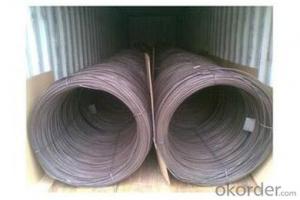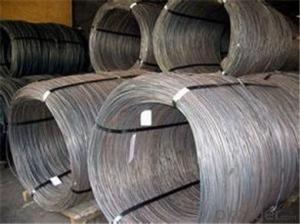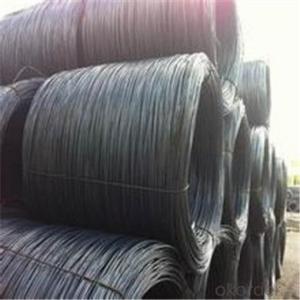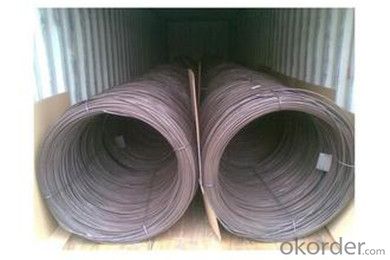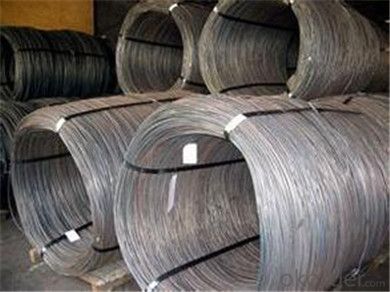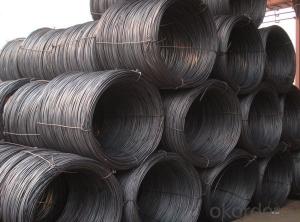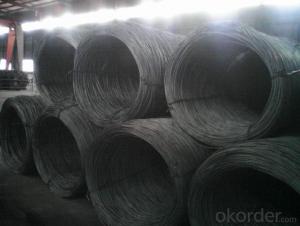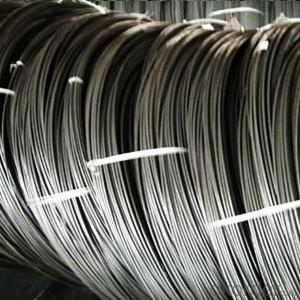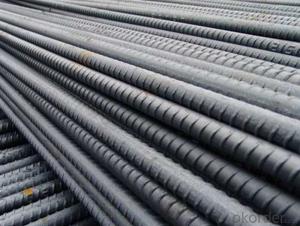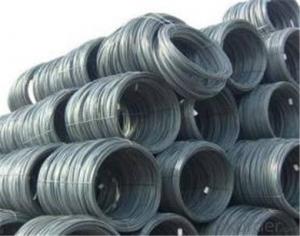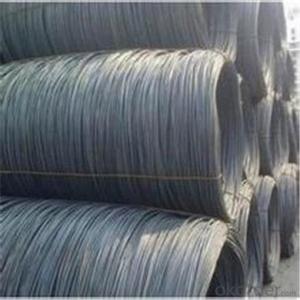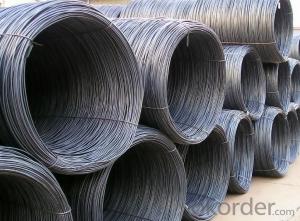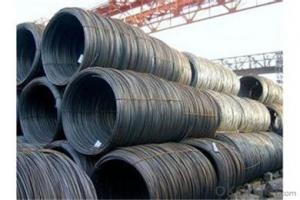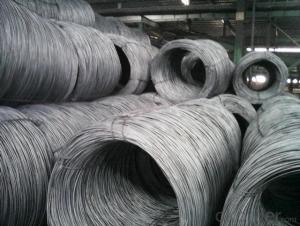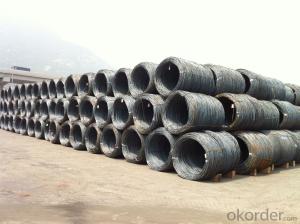SAE1008Gr Steel Wire rod 5.5mm with Best Quality in China
- Loading Port:
- Shanghai
- Payment Terms:
- TT OR LC
- Min Order Qty:
- 99 m.t.
- Supply Capability:
- 45555555 m.t./month
OKorder Service Pledge
OKorder Financial Service
You Might Also Like
Specification
Description of wire Rod:
wire rod:
Grade:SAE1006B/SAE1008B/SAE1018B
Size:5.5/6.5/7/8/9/10/11/12mm
Festures of wire Rod:
1. Drawn wire specialist, your wire rod solution
2. ISO9001 Certified Mill &SGS
3. Feature: machinability, high hardness, toughness, corrosion resistant
4. Clear and smooth surface, high precision and Tolerance control: ± 0.01
5. Customized service for your special requirement
6. Reasonable and more competitive mill price for you.
Specifications of wire Rod:
Product | steel wire rod |
Standard | AISI, ASTM, BS, DIN, GB, JIS |
Material/steel grade | Q195-Q235,SAE1006, SAE1008, SAE1010, SAE1018, SAE1020 or according to customers requirements |
Wire Gauge | 5.5-12mm |
Coil weight | 1.8-2.1mts |
MOQ | 25MT |
Delivery Time | 15-30 days after receipt of L/C or deposit by T/T |
Packing | In coil and load in container, if large quantity, by bulk vessel; Can be packed as customers' special requirements |
Payment terms | 1).100% irrevocable L/C at sight. |
Application | widely used in machinery parts, manufacturing industry, electronics industry, metal tools and others |
FAQ: 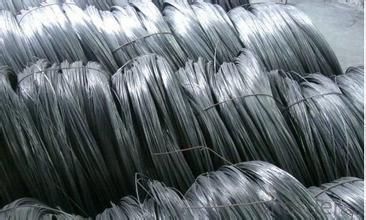 Images of wire Rod:
Images of wire Rod:
1. What is your package?
Packing situation: standard seaworthy packing or as customer required.
2. How long is the lead time?
Delivery time: 45 days after order confirmed.
3. What payment term do you accept?
Payment: T/T or L/C at sight.
- Q: What are the different toughness testing methods for steel wire rod?
- There are several different toughness testing methods that can be used to assess the strength and durability of steel wire rods. Some of the commonly employed techniques are: 1. Charpy Impact Test: This method involves striking a notched specimen with a pendulum hammer and measuring the energy absorbed during fracture. It provides an indication of the material's resistance to impact loading and can be used to evaluate the ductile-to-brittle transition temperature. 2. Izod Impact Test: Similar to the Charpy test, the Izod method measures the energy absorbed by a notched specimen when struck by a swinging pendulum. This test is particularly useful for assessing the toughness of materials with low impact resistance. 3. Tensile Testing: This method involves subjecting a wire rod to a gradually increasing tensile force until it fractures. By measuring the maximum force applied and the elongation at fracture, the tensile strength and ductility of the steel can be determined. Although tensile testing does not directly measure toughness, it provides valuable information about the material's mechanical properties. 4. Bend Test: In this test, a steel wire rod is bent to a specified angle and inspected for signs of cracking or fracture. The ability of the material to withstand bending without failure is indicative of its toughness and ductility. 5. Hardness Testing: Hardness tests, such as the Rockwell or Brinell test, measure the resistance of a material to indentation. Although hardness is not a direct measure of toughness, it can provide an indication of the material's strength and ability to resist deformation. 6. Fracture Toughness Testing: This method involves measuring the critical stress intensity factor (KIC) or fracture toughness of a material. It provides information about how the material will behave under stress, including its resistance to crack propagation. Overall, these toughness testing methods help in evaluating the performance and suitability of steel wire rods for various applications, such as construction, manufacturing, and engineering. The choice of testing method depends on the specific requirements and characteristics of the material being assessed.
- Q: How is steel wire rod used in the manufacturing of wire forms for furniture?
- Steel wire rod is a crucial component in the manufacturing of wire forms for furniture. It is used in various ways to create sturdy and durable wire structures that are essential in the construction of furniture pieces. Firstly, steel wire rod serves as the primary material for producing the wires used in furniture manufacturing. The wire rod is typically drawn through a series of dies to achieve the desired diameter and shape. These wires are then used to form the framework of various furniture items such as chairs, tables, and shelving units. Additionally, steel wire rod is often used to create springs for furniture. Springs are an integral part of furniture construction as they provide support, comfort, and flexibility to the seating or bedding surface. By using steel wire rod, manufacturers can produce high-quality springs that are resilient and long-lasting. Moreover, steel wire rod is used for reinforcing certain parts of furniture. For instance, it can be incorporated into the structure of a chair to reinforce the legs or the backrest, ensuring stability and preventing any potential damage or breakage. Furthermore, steel wire rod is utilized for creating decorative elements in furniture design. It can be bent, twisted, or shaped into intricate patterns or designs to enhance the aesthetics of the furniture piece. These decorative wire forms can be used as accents, handles, or even as the main design feature of the furniture item. Overall, steel wire rod plays a critical role in the manufacturing of wire forms for furniture. Its strength, versatility, and durability make it an ideal material for creating the framework, springs, reinforcements, and decorative elements required in furniture construction.
- Q: How are steel wire rods used in the production of wire cables for transmitting signals?
- Steel wire rods are used in the production of wire cables for transmitting signals as they provide strength and durability to the cables. These rods are typically drawn through a series of dies to reduce their diameter and increase their length, resulting in a wire with high tensile strength and flexibility. This wire is then twisted or braided together to form the cable, which can effectively transmit signals due to the conductivity of steel.
- Q: What are the different hardness testing methods for steel wire rod?
- There are several different hardness testing methods that can be used to evaluate the hardness of steel wire rods. These methods include: 1. Rockwell Hardness Test: This is one of the most commonly used methods for hardness testing. It involves indenting the surface of the steel wire rod using a diamond cone or steel ball. The depth of the indentation is measured and correlated to a hardness value. 2. Brinell Hardness Test: This method also involves indenting the surface of the steel wire rod, but with a larger ball compared to the Rockwell test. The diameter of the indentation is measured and converted to a hardness value. 3. Vickers Hardness Test: This method uses a square-based diamond pyramid indenter to create an indentation on the surface of the steel wire rod. The size of the indentation is measured and the hardness value is calculated based on the applied load and the surface area of the indentation. 4. Knoop Hardness Test: This method is similar to the Vickers test, but it uses a rhombic-based diamond indenter instead. The length of the indentation is measured and the hardness value is calculated based on the applied load and the projected area of the indentation. 5. Microhardness Testing: This method involves using a microhardness tester to measure the hardness of the steel wire rod at a microscopic level. It is particularly useful for evaluating the hardness of different regions within the wire rod or for evaluating smaller samples. These different hardness testing methods provide valuable information about the mechanical properties of steel wire rods, allowing manufacturers to ensure that the rods meet the required hardness specifications for their intended applications.
- Q: How are steel wire rods tested for quality control?
- Steel wire rods are tested for quality control through a series of rigorous procedures to ensure that they meet the required standards and specifications. The testing process involves various stages that evaluate the physical, mechanical, and chemical properties of the wire rods. Firstly, the wire rods undergo visual inspection where they are examined for any visible defects such as surface cracks, irregularities, or deformities. This step helps in identifying any visual flaws that may affect the overall quality of the wire rods. Next, the wire rods are subjected to dimensional measurements to verify their diameter, length, and straightness. This ensures that the wire rods meet the specified tolerances and are within the acceptable limits. Mechanical testing is then performed to assess the strength and durability of the wire rods. Tensile strength tests are conducted to measure the maximum load a wire rod can bear before breaking. This test determines the material's ability to withstand external forces and is crucial in assessing its overall quality. Chemical analysis is another critical aspect of quality control testing. Wire rods are tested for their chemical composition to ensure that they contain the required elements in the specified proportions. This analysis helps in verifying the material's suitability for its intended application and ensures that it meets industry standards. Furthermore, non-destructive testing methods like ultrasonic testing or magnetic particle inspection may be utilized to detect internal flaws or defects that may not be visible to the naked eye. These testing techniques help in identifying any hidden issues that could compromise the quality of the wire rods. Overall, the quality control process for steel wire rods involves a combination of visual inspection, dimensional measurements, mechanical testing, chemical analysis, and non-destructive testing. By adhering to these strict quality control measures, manufacturers can ensure that their wire rods meet the required standards and provide reliable and high-quality products to their customers.
- Q: What are the common production processes for copper-coated steel wire rod?
- The common production processes for copper-coated steel wire rod typically involve wire drawing, cleaning, copper coating, annealing, and spooling.
- Q: How is steel wire rod straightened after the rolling process?
- Steel wire rod is straightened after the rolling process through a mechanical process known as straightening. The rod passes through a series of rotating rollers that apply pressure and tension to remove any deformities and bends, ultimately resulting in a straightened wire rod.
- Q: How are steel wire rods used in the manufacturing of piano strings?
- Steel wire rods are used in the manufacturing of piano strings as they provide the necessary strength and flexibility required for producing high-quality and durable strings.
- Q: What are the main factors influencing the choice of steel wire rod delivery time?
- The main factors influencing the choice of steel wire rod delivery time are the availability of raw materials, production capacity and efficiency, logistical capabilities, market demand, and any unforeseen external factors such as weather conditions or transportation delays.
- Q: What are the different grain size measurement methods for steel wire rod?
- There are several grain size measurement methods for steel wire rod, including optical microscopy, electron backscatter diffraction (EBSD), X-ray diffraction (XRD), and image analysis. Optical microscopy involves examining the sample under a microscope and measuring the average grain size. EBSD is a technique that uses electron diffraction patterns to determine the crystal orientation and grain size. XRD measures the diffraction pattern of X-rays to determine the crystal structure and grain size. Image analysis involves capturing images of the sample and using software to analyze and measure the grain size.
Send your message to us
SAE1008Gr Steel Wire rod 5.5mm with Best Quality in China
- Loading Port:
- Shanghai
- Payment Terms:
- TT OR LC
- Min Order Qty:
- 99 m.t.
- Supply Capability:
- 45555555 m.t./month
OKorder Service Pledge
OKorder Financial Service
Similar products
Hot products
Hot Searches
Related keywords
